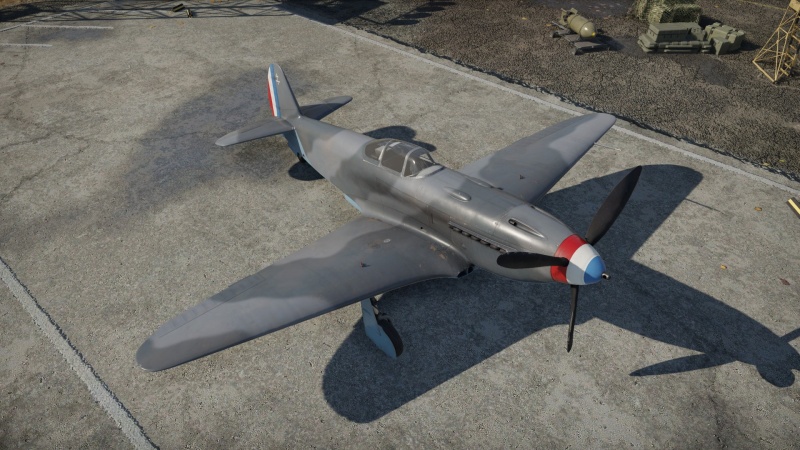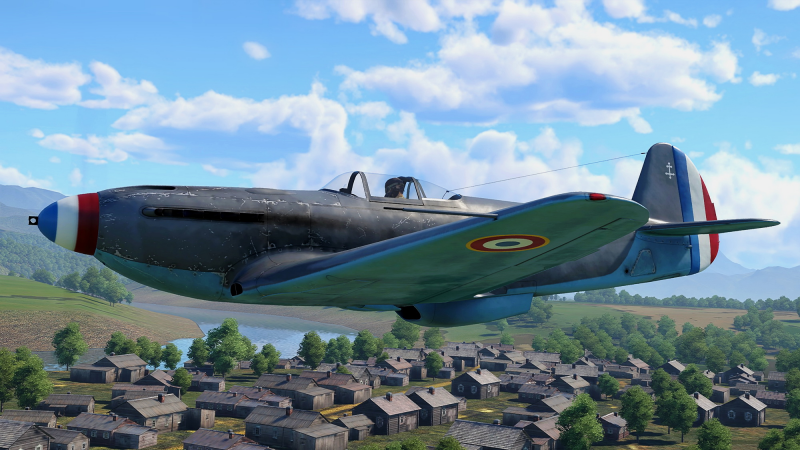Yak-3 (France)
| This page is about the French premium fighter Yak-3 (France). For other versions, see Yak-3 (Family). |
Contents
Description
Normandie-Nieman was a Free French Air Force squadron that was created in 1942 and is quite famous. After Operation Barbarossa started, Soviet officials wanted their diplomats in France to return to the Soviet Union. This, along with Charles de Gaulle's ambition for French pilots to serve on all fronts of the war, led to the squadron also serving on the Eastern Front. The squadron arrived at Ivanovo Air Base in November 1942 and was trained with several Yak variants. Over the years, the squadron grew its kill tally to an impressive 200+ kills claimed. Nearing the end of the war, the squadron's main fighter was the Yak-3, which would also be used after the war. However, due to the lack of spare parts, many French Yak-3s were cannibalized to keep others airworthy until the situation was untenable. Soon after, they were retired, with one surviving in an airport to this day. The squadron still lives as well and now flies Dassault Rafales.
The ▄Yak-3 was introduced as a premium fighter during Update 1.77 "Advancing Storm". The Yak-3 is an incredibly dangerous aircraft with its excellent performance, handling, and guns. Like many Yakovlev fighters, the Yak-3 is no exception to being able to manoeuvre well. It has very good manoeuvring energy retention, and the climb rate is also quite high at over 21 m/s. However, Soviet fighters were typically suited for low altitude, and the Yak-3 drops off in power at 5,000 metres and above (16,200 feet). Furthermore, since the Yak-3 is made out of wood, it has a low structural limit of 685 km/h (425 mph), so players need to be extra careful when going into dives. The Yak-3 is an excellent fighter for players to learn energy fighting and basic dogfighting tactics.
General info
Flight performance
| Characteristics | Max Speed (km/h at 4,100 m) |
Max altitude (metres) |
Turn time (seconds) |
Rate of climb (metres/second) |
Take-off run (metres) | |||
|---|---|---|---|---|---|---|---|---|
| AB | RB | AB | RB | AB | RB | |||
| Stock | 633 | 615 | 18.3 | 18.9 | 17.9 | 17.9 | 348 | |
| Upgraded | 674 | 654 | 17.2 | 17.4 | 24.3 | 21.3 | ||
Details
| Features | ||||
|---|---|---|---|---|
| Combat flaps | Take-off flaps | Landing flaps | Air brakes | Arrestor gear |
| X | X | ✓ | X | X |
| Limits | ||||||
|---|---|---|---|---|---|---|
| Wings (km/h) | Gear (km/h) | Flaps (km/h) | Max Static G | |||
| Combat | Take-off | Landing | + | - | ||
| N/A | N/A | 320 | ~12 | ~9 | ||
| Optimal velocities (km/h) | |||
|---|---|---|---|
| Ailerons | Rudder | Elevators | Radiator |
| < 380 | < 420 | < 490 | > 340 |
Survivability and armour
- 8.5 mm steel behind pilot
- 10 mm steel on top of rear cockpit
- 64 mm bulletproof
- Self-sealing fuel tanks (1 under pilot, 1 in each wing)
Modifications and economy
Armaments
Offensive armament
The Yak-3 (France) is armed with:
- 1 x 20 mm ShVAK cannon, nose-mounted (120 rpg)
- 2 x 12.7 mm Berezin UB machine guns, nose-mounted (150 rpg = 300 total)
Usage in battles
The Yak-3 is the pinnacle of the piston engine Yakovlev design, with a much more powerful engine, the addition of a second MG (meaning the MGs are viable now!), though metal wings were not yet added until the Yak-9. The coolant system, now actually somewhat effective, has been moved to the wing roots (no "smiley face" below the nose), making the plane more streamlined. The cannon - the same old 20 mm ShVak - receives a pleasant upgrade: very effective Air Targets belts.
Boasting incredible engine performance on a light and agile airframe, you can easily climb with, or even outclimb your contemporary fighters, allowing you maintain an energy advantage over some at the start of a match. Unlike some of the other energy-fighters you will come across (Bf-109s and such), the Yak-3 has incredible maneuverability compared to them, found in its roll rate and turn radius. Its energy retention and engine power alone allow you to almost indefinitely hold a horizontal turn, making this plane an excellent dogfighter and can let you play both as a turn-fighter of sorts or a dedicated energy-fighter.
Flight performance of the Yak-3 is outstanding. While it can't out-turn the likes of a Zero, or execute Boom-and-Zoom tactics as well as a Bf-109, it can certainly handle nearly everything it will face. This plane truly excels at long and slow dogfights, where the engine power will allow you to recover from any turn with ease. The landing flaps, albeit rather weak, making stall-fighting and turning effectively under 300 km/h trivial, and will certainly help when dealing with enemies that outclass you in one area. The Yak can easily handle said stall maneuvers, and low-speed turns you may find yourself in. Most planes will have lost most of their speed and will struggle to accelerate in these conditions, making maneuvers like the high yo-yo absurdly useful.
Always beware of true turn-fighters (Spitfires, Zeros), as they may be able to take you down before you can force them to bleed energy. It is generally recommended to maintain an energy advantage (altitude is best), so they can never have a fight on their own terms. If in a dogfight with a turn-fighter, the Yak's agility can be a major aid in staying out of your opponent's flight path, so capitalize on this as best you can. As stated above, forcing your enemy to turn while staying untouched can allowing you to pull maneuvers quickly and accelerate when speed is needed to get on your enemies tail.
Even with the climbing performance the Yak offers, bomber-hunting isn't recommended. You have a very limited ammunition supply making even extending dogfights with more than one enemy stressful. Thankfully, the weapons you get won't disappoint. Both your gun and cannon have good muzzle velocities with high rates of fire, and are effective all-around. Try to only hold bursts of a few rounds at a time to maximize damage potential while preserving ammo for later fights.
While certainly outperformed in areas like turn rates and BnZ potential, the Yak can accomplish any feat with proper skill from the pilot, making for one of the best multirole fighters currently in-game.
Manual Engine Control
| MEC elements | ||||||
|---|---|---|---|---|---|---|
| Mixer | Pitch | Radiator | Supercharger | Turbocharger | ||
| Oil | Water | Type | ||||
| Controllable | Controllable Not auto controlled |
Controllable Auto control available |
Controllable Auto control available |
Separate | Controllable 2 gears |
Not controllable |
Pros and cons
Pros:
- Stellar engine performance
- Stall and vertical maneuvers are effective and easy
- Energy retention is on-par with Bf-109s
- Surprisingly very agile, with a great turn and roll rate
- Doesn't struggle or begin to feel sluggish at low speeds
- Effective armament
- Great acceleration
Cons:
- Mediocre rip speed - worsened by its powerful engine
- No combat flaps, only equipped with landing flaps
- No WEP, engine overheats at 100%
- Poor engine performance above 5 km
- Long bursts and bomber-hunting will quickly drain your ammo pool
History
The idea to produce a new fighter for the Red Army Air Force went as far back as 1941. It was then that the Yakovlev Design Bureau presented the I-30 prototype, intended an alternative to the earlier Yak-1 design. However, the German invasion of the USSR, as well as aluminium shortages, meant that the project had to be put on hold. Yakovlev resumed the development in 1943 while working on an upgraded version of the Yak-1 fighter. This time, it was decided that a new aircraft should be produced to completely replace the Yak-1 and Yak-7 models.
By September 1943, yet another improved variant was ready, designated Yak-1M Dubler, on which the canvas skin on the tail section was replaced with 2 mm plywood, and oil and water radiators were improved. The Dubler also had a new mastless antenna, a ring sight instead of a reflector sight, improved armour and a new propeller. Test pilots were impressed by the new prototype. Their report stated in part: "Yak-1M possessed excellent horizontal, and especially vertical, manoeuvrability. Top speed greatly improved compared to earlier serial-production Yaks. Despite the improved performance, the aircraft remains easy to fly and does not require extensive pilot training."
The new machine was dubbed as the Yak-3 and entered service with the Red Army Air Force in 1944. The Yak-3 was a further modification of the Yak-1, produced in 1944 and 1945, with a total of 4,848 built, and considered one of the best fighters of the war.
The new fighter quickly became very popular with Soviet pilots. They highly praised its solid armament of two Berezin UBS 12.7 mm machine guns and one ShVAK 20 mm cannon as well as ease of piloting and superb low-altitude performance. Marcel Albert, the top scoring French ace of World War II, cited the Yak-3 as one of the best fighters of the war, along with the P-51 Mustang and the Supermarine Spitfire. After the war, the Yak-3 was also used by the Air Forces of Socialist Yugoslavia and Poland.[1]
Media
- Skins
- Videos
See also
Links to the articles on the War Thunder Wiki that you think will be useful for the reader, for example:
- reference to the series of the aircraft;
- links to approximate analogues of other nations and research trees.
External links
References
| A.S. Yakovlev Design Bureau (Яковлев Опытное конструкторское бюро) | |
|---|---|
| Fighters | |
| Yak-1 | Yak-1 · Yak-1B |
| Yak-3 | Yak-3 · Eremin's Yak-3(e) · Yak-3 (VK-107) · Yak-3P · Yak-3T · Yak-3U |
| Yak-7 | Yak-7B |
| Yak-9 | Yak-9 · Yak-9B · Yak-9K · Golovachev's Yak-9M · Yak-9P · Yak-9T · Yak-9U · Yak-9UT |
| Twin-engine fighters | I-29 |
| Jet fighters | |
| Yak-15 | Yak-15P · Yak-15 |
| Yak-17 | Yak-17 |
| Yak-23 | Yak-23 |
| Yak-30 | Yak-30D |
| Yak-141 | Yak-141 |
| Strike aircraft | |
| Yak-2 | Yak-2 KABB |
| Yak-38 | Yak-38 · Yak-38M |
| Bombers | Yak-4 |
| Jet bombers | Yak-28B |
| Foreign use | ▄Yak-3 · Challe's ▄Yak-9T · ◔Yak-9P |
| Captured | ▀Yak-1B |
| France fighters | |
|---|---|
| Dewoitine | D.371 · D.371 H.S.9 · D.373 · D.500 · D.501 · Pallier's D.510 · D.520 |
| Morane-Saulnier | M.S.405C1 · M.S.406C1 · M.S.410 |
| Arsenal | V.G.33C-1 |
| Bloch | M.B.152C1 · M.B.157 |
| Caudron | C.R.714 |
| Sud-Ouest | S.O.8000 Narval |
| American | H-75A-1 · H-75A-4 · ▄P-39Q-25 · ▄P-40F-5 Lafayette · ▄P-47D-22-RE · ▄P-63C-5 · F-6C-10-NA |
| ▄F6F-5 · ▄F6F-5N · F4U-7 · ▄F8F-1B | |
| Other countries | ▄Seafire LF Mk.III · ▄Yak-3 · Challe's ▄Yak-9T · NC.900 |
| Belgium | ▄Gladiator Mk I · ▄Spitfire FR Mk XIVe |
| Netherlands | ◘Sea Fury FB 51 |
| France premium aircraft | |
|---|---|
| Fighters | D.371 H.S.9 · Pallier's D.510 · ▄P-39Q-25 · ▄P-40F-5 Lafayette · ▄P-47D-22-RE · F-6C-10-NA |
| M.B.152C1 · ▄Yak-3 · Challe's ▄Yak-9T · NC.900 · S.O.8000 Narval | |
| Jet fighters | ◘Sea Hawk Mk.50 · Milan · Mirage F1C-200 |
| Strike aircraft | ▄AD-4NA · F-84F IAF |
| Bombers | Late 298D · ▄PBY-5A Late |
| Jet bombers | Vautour IIA IDF/AF · S.O.4050 Vautour IIN |






